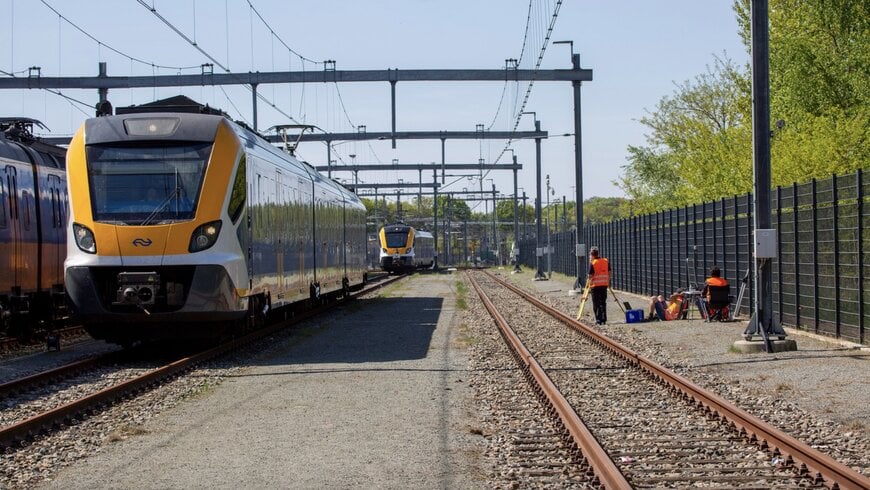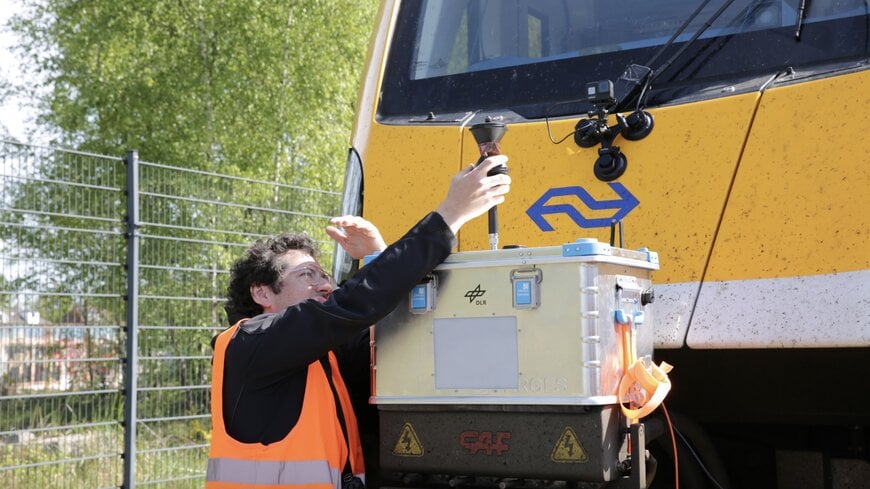railway-international.com
15
'25
Written on Modified on
DLR tests virtual coupling system in the real world
The solution, based on ultra-wideband technology, enables fast and precise communication, positioning and distance measurement over short distances.
www.dlr.de

The R2DATO system passed its first real-world test on a technical track area belonging to the Dutch national railway operator Nederlandse Spoorwegen (NS) in Amersfoort. Over a 350-metre stretch, two regional trains equipped with DLR's system travelled one behind the other at intervals of 15 to 80 metres – extremely close distances by railway standards.
Advancing automation in train operations is one way to transport more people and goods on the existing rail network. A key technology for this is the virtual coupling of train cars and formations. In this system, individual cars are no longer mechanically connected by a coupling, but only digitally – that is, they travel at a fixed, close distance behind one another. For this to work, the sections of the train must constantly communicate with each other and exchange highly precise data about their respective positions and speeds. In the R2DATO project, the German Aerospace Center (Deutsches Zentrum für Luft- und Raumfahrt; DLR) has developed a novel radio system for this purpose and successfully tested it on a closed railway site.
As part of the project, the DLR Institute of Communications and Navigation primarily investigated decentralised, direct communication between trains when they are relatively close to one another. "We're talking about distances of 20 to 200 metres, which is needed for virtual coupling," says project manager Paul Unterhuber. "For the railway sector, that is extremely close because, depending on the speed, braking distances can range from several hundred metres to a kilometre."
Ultra-wideband technology for fast and precise communication, positioning and distance measurement over short distances
The system developed and tested by DLR for this purpose uses ultra-wideband (UWB) communication. This radio technology transmits data across an extremely wide frequency spectrum and enables precise positioning and data transfer over short distances. UWB is currently used in smartphones, small tracking devices for indoor or industrial use and car keys for locking and unlocking vehicles. "A further advantage of UWB is that it enables us to calculate the distance between two trains very precisely," explains Unterhuber. "To do this, we use what is known as latency. This is the time it takes for data packets to travel from the transmitter to the receiver – giving us all the information we need to control acceleration and braking processes in the close range that is crucial for virtual coupling."

For the first real-world tests, the system developed by DLR was mounted in two compact boxes on the mechanical couplings at the front of the trains.
The system developed for the R2DATO project also features a laser-based measurement system. This serves as a reference system, gauging the distance between trains to evaluate the accuracy of the UWB measurements. Batteries supply power to all system components.
Track debut – close spacing demands special attention
The first tests took place at the end of April 2025 on a technical track area belonging to the Dutch national railway operator Nederlandse Spoorwegen (NS) in Amersfoort, the Netherlands. Two regional trains equipped with DLR's radio system ran up and down a 350-metre stretch several hundred times. The DLR system was housed in two compact boxes mounted on the mechanical couplings on the front of the trains. A third box on the ground served as a base station and collected additional data.
The two trains simulated multiple different scenarios at speeds ranging from 10 to 25 kilometres per hour – for instance, running one behind another at distances of 15 to 80 metres, or with only one train moving while the other remained stationary. The trains were controlled by train drivers – a demanding task due to the short distances involved. For comparison, the DLR team also provided the train drivers with live information from the DLR system on a separate monitor. "The drivers welcomed this additional information, because it made control much simpler,” Unterhuber continues. "In the future, data from such systems will not only support train drivers but also contribute to largely automated or even autonomous train operations."
Feasibility demonstrated in a railway setting
The initial test results gave the team cause for optimism, demonstrating that the distance between the two trains could be determined to within a few centimetres – something not possible with the technologies previously used in the railway sector. "Generally speaking, our tests showed that communication between trains and the resulting distance calculations work in real-life railway settings, at distances from a few metres up to 350 metres," says Unterhuber. "We have demonstrated proof of concept – the feasibility of our concept in practice. Now we are continuing to evaluate the data collected so that we can make further statements about the precision and reliability of the DLR system."
The Next-Generation Train TAXI (NGT-TAXI) concept, developed as part of DLR's rail transport research, also relies on virtually coupled train sections. NGT-TAXI is designed to enable automated train operation on branch lines, making these routes more attractive again. It will operate on demand, virtually coupling multiple train carriages depending on the number of passengers.
Advancing automation in train operations is one way to transport more people and goods on the existing rail network. A key technology for this is the virtual coupling of train cars and formations. In this system, individual cars are no longer mechanically connected by a coupling, but only digitally – that is, they travel at a fixed, close distance behind one another. For this to work, the sections of the train must constantly communicate with each other and exchange highly precise data about their respective positions and speeds. In the R2DATO project, the German Aerospace Center (Deutsches Zentrum für Luft- und Raumfahrt; DLR) has developed a novel radio system for this purpose and successfully tested it on a closed railway site.
As part of the project, the DLR Institute of Communications and Navigation primarily investigated decentralised, direct communication between trains when they are relatively close to one another. "We're talking about distances of 20 to 200 metres, which is needed for virtual coupling," says project manager Paul Unterhuber. "For the railway sector, that is extremely close because, depending on the speed, braking distances can range from several hundred metres to a kilometre."
Ultra-wideband technology for fast and precise communication, positioning and distance measurement over short distances
The system developed and tested by DLR for this purpose uses ultra-wideband (UWB) communication. This radio technology transmits data across an extremely wide frequency spectrum and enables precise positioning and data transfer over short distances. UWB is currently used in smartphones, small tracking devices for indoor or industrial use and car keys for locking and unlocking vehicles. "A further advantage of UWB is that it enables us to calculate the distance between two trains very precisely," explains Unterhuber. "To do this, we use what is known as latency. This is the time it takes for data packets to travel from the transmitter to the receiver – giving us all the information we need to control acceleration and braking processes in the close range that is crucial for virtual coupling."

For the first real-world tests, the system developed by DLR was mounted in two compact boxes on the mechanical couplings at the front of the trains.
The system developed for the R2DATO project also features a laser-based measurement system. This serves as a reference system, gauging the distance between trains to evaluate the accuracy of the UWB measurements. Batteries supply power to all system components.
Track debut – close spacing demands special attention
The first tests took place at the end of April 2025 on a technical track area belonging to the Dutch national railway operator Nederlandse Spoorwegen (NS) in Amersfoort, the Netherlands. Two regional trains equipped with DLR's radio system ran up and down a 350-metre stretch several hundred times. The DLR system was housed in two compact boxes mounted on the mechanical couplings on the front of the trains. A third box on the ground served as a base station and collected additional data.
The two trains simulated multiple different scenarios at speeds ranging from 10 to 25 kilometres per hour – for instance, running one behind another at distances of 15 to 80 metres, or with only one train moving while the other remained stationary. The trains were controlled by train drivers – a demanding task due to the short distances involved. For comparison, the DLR team also provided the train drivers with live information from the DLR system on a separate monitor. "The drivers welcomed this additional information, because it made control much simpler,” Unterhuber continues. "In the future, data from such systems will not only support train drivers but also contribute to largely automated or even autonomous train operations."
Feasibility demonstrated in a railway setting
The initial test results gave the team cause for optimism, demonstrating that the distance between the two trains could be determined to within a few centimetres – something not possible with the technologies previously used in the railway sector. "Generally speaking, our tests showed that communication between trains and the resulting distance calculations work in real-life railway settings, at distances from a few metres up to 350 metres," says Unterhuber. "We have demonstrated proof of concept – the feasibility of our concept in practice. Now we are continuing to evaluate the data collected so that we can make further statements about the precision and reliability of the DLR system."
The Next-Generation Train TAXI (NGT-TAXI) concept, developed as part of DLR's rail transport research, also relies on virtually coupled train sections. NGT-TAXI is designed to enable automated train operation on branch lines, making these routes more attractive again. It will operate on demand, virtually coupling multiple train carriages depending on the number of passengers.
www.dlr.de

